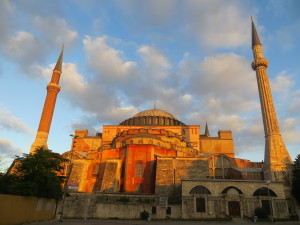 One of the great joys in life is seeing something in person that you’ve studied. Visiting a world class, historic landmark brings the geography, human ingenuity, and often years of struggle to life. It adds depth. It gives perspectives often missed from reading a book.
One of the great joys in life is seeing something in person that you’ve studied. Visiting a world class, historic landmark brings the geography, human ingenuity, and often years of struggle to life. It adds depth. It gives perspectives often missed from reading a book.
I visited two world class locations this past week during a quick worktrip. I visited Cairo for work and was able to run along the Nile, visit the Pyramids and view the treasures of the Egyptian Museum. After missing a connecting flight, I spent 24 hours in Istanbul and visited Hagia Sophia, the Blue Mosque, a Roman underground cistern, and hiked Istanbul’s bazaars & Galata bridge during a 5 mile sunset hike.
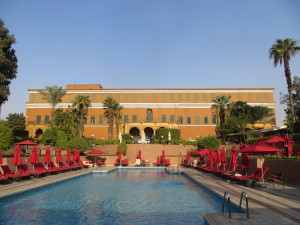 Cairo is a city of 20 million people surrounded by desert and bisected by the Nile. It is a busy place. The sounds of cars honking waft through the air on sunrise jogs. I stayed at a historic hotel (heavily secured) on the island of Gezira, the Nile near Tahrir Square, the Egyption Museum, and many businesses, and Western hotels.
Cairo is a city of 20 million people surrounded by desert and bisected by the Nile. It is a busy place. The sounds of cars honking waft through the air on sunrise jogs. I stayed at a historic hotel (heavily secured) on the island of Gezira, the Nile near Tahrir Square, the Egyption Museum, and many businesses, and Western hotels.
The Pyramids sit on the edge of Cairo (in Giza)
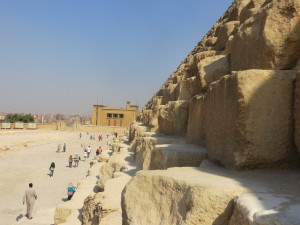 and the Sahara desert. As you drive toward the Pyramids, you can see them rise above the apartments dotting Cairo. I did not appreciate
and the Sahara desert. As you drive toward the Pyramids, you can see them rise above the apartments dotting Cairo. I did not appreciate
their scale until I came face to face with the Great Pyramid, Khufu. Built around 2560 BC, Khufu or Cheops is the largest pyramid at 481 feet tall. It is the only seven wonders of the ancient world still standing. Walking on the pyramid highlights the steepness and size of the foundation blocks. We next drove to an overlook of the pyramids. Vendors, camels, and 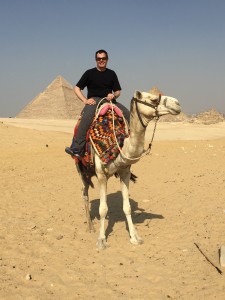 horses dotted the area. You could also appreciate the dirt and sand of the Sahara Desert. I took a camel ride and almost fell off. We finished at the Sphinx and the catacomb area where the mummies were prepared. The spinx gave a more manageable size that would help w comparing with the pyramids. The Nile is now several miles from the Pyramid, but once flowed in front the Sphinx area.
horses dotted the area. You could also appreciate the dirt and sand of the Sahara Desert. I took a camel ride and almost fell off. We finished at the Sphinx and the catacomb area where the mummies were prepared. The spinx gave a more manageable size that would help w comparing with the pyramids. The Nile is now several miles from the Pyramid, but once flowed in front the Sphinx area.
The size, grandeur, craftsmanship of the Egyptians and Pyramids are awe inspiring. They are built to last – having been there almost 5000 years.
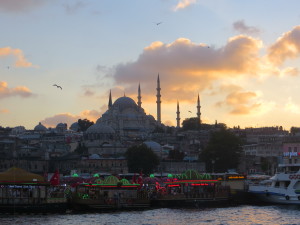 Istanbul (or Byzantium, Constantinople) is a relative newcomer compared to the pyramids. Originally by the Greeks in the 600s BC, it became the Eastern capital of the Roman Empire in 330 AD by the Emperor Constantine. Istanbul is a Peninsula surrounded by the Bosporus Straits, the Sea of Marmara, and the Golden Horn. It guards the border between Europe and Asia, and the Black Sea and the Mediterranean Sea.
Istanbul (or Byzantium, Constantinople) is a relative newcomer compared to the pyramids. Originally by the Greeks in the 600s BC, it became the Eastern capital of the Roman Empire in 330 AD by the Emperor Constantine. Istanbul is a Peninsula surrounded by the Bosporus Straits, the Sea of Marmara, and the Golden Horn. It guards the border between Europe and Asia, and the Black Sea and the Mediterranean Sea.
I missed a connecting flight home and was able to spend 24 hours in Istanbul. On Friday  evening, I took an outstanding ~5 mile hike around Istanbul. I started in the historic Sultanahmet district. My coworker and I walked toward the Blue Mosque. New trams sped past us with Hagia Sofia silhouette straight ahead. The blue mosque was built in the 1600s to rival its neighbor Hagia Sophia by Ottoman sultans. It’s outer façade, highlighted by the sunrise or evening lights are magical.
evening, I took an outstanding ~5 mile hike around Istanbul. I started in the historic Sultanahmet district. My coworker and I walked toward the Blue Mosque. New trams sped past us with Hagia Sofia silhouette straight ahead. The blue mosque was built in the 1600s to rival its neighbor Hagia Sophia by Ottoman sultans. It’s outer façade, highlighted by the sunrise or evening lights are magical.
In front of the Blue Mosque are the grounds of the former Hippodrome of Byzantine. Constantine moved some Egyptian Obelisks from Thebes to mark the Chariot Race path.
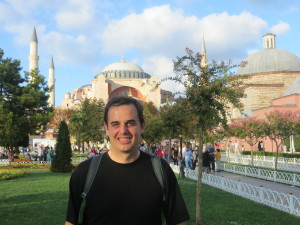 Next to the Blue Mosque is the Hagia Sophia (or Aya Sofya). The Byzantine Emperor, Justinian, built Hagia Sophia in 537 AD. It is impressive from the outside and magnificent from the inside. On Saturday, I walked inside, and my history books did not do it justice. I could not appreciate the scale and detail of this open air space. It was so large I could not figure out how to take pictures. I can just imagine how awestruck someone from the countryside 1000 years ago would be seeing the Hagia Sophia. I was amazed in 2015.
Next to the Blue Mosque is the Hagia Sophia (or Aya Sofya). The Byzantine Emperor, Justinian, built Hagia Sophia in 537 AD. It is impressive from the outside and magnificent from the inside. On Saturday, I walked inside, and my history books did not do it justice. I could not appreciate the scale and detail of this open air space. It was so large I could not figure out how to take pictures. I can just imagine how awestruck someone from the countryside 1000 years ago would be seeing the Hagia Sophia. I was amazed in 2015.
On the hike I walked past the Topkaki Palace, its walls, and its outer place gardens to the  Golden Horn. Ferries of all sizes crossed the Golden Horn and the Bosporous. The Galata Bridge beneath the Genosesse Galata Tower is the closest bridge to the Bosporous. Watching the sun set on Europe and Asia was outstanding. The fisherman on the bridge focused on watching their lines.
Golden Horn. Ferries of all sizes crossed the Golden Horn and the Bosporous. The Galata Bridge beneath the Genosesse Galata Tower is the closest bridge to the Bosporous. Watching the sun set on Europe and Asia was outstanding. The fisherman on the bridge focused on watching their lines.
I walked into the Spice Market Bazaar. The signs, smells, and colors were huge with its many spice, fish, and other stands. From the Spice Market, I walked uphill to complete the circle toward the Grand Bazaar. The Grand Bazaar 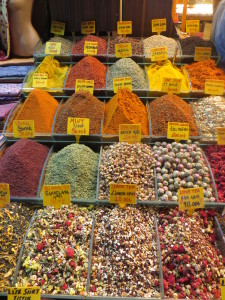 was closing soon, but the guarded doors were still open. I experienced the shops in the evening twilight. We exited the Bazaar at a mosque and immediately entered a tree lined European style neighborhood. I walked down the main street back toward the Hagia Sophia and found a place to eat.
was closing soon, but the guarded doors were still open. I experienced the shops in the evening twilight. We exited the Bazaar at a mosque and immediately entered a tree lined European style neighborhood. I walked down the main street back toward the Hagia Sophia and found a place to eat.
On Saturday morning, I watched the sunrise greet the Hagia Sophia, the Blue Mosque, and Istanbul. After a morning jog, I visited Hagia Sophia at opening time. My last Istanbul sight was another site commissioned by Justinian, the Basilica Cistern from 532 AD. Visitors might recognize it from Russia with Love when James Bond searches the Russian Embassy. The area features an underground pool the size of several football fields. Ornate columns and sculptures support the ceiling. The area was forgotten for over 1000 years, but like the pyramids and Hagia Sophia, it was built to last. It left an evocative and eerie last sight of Istanbul.
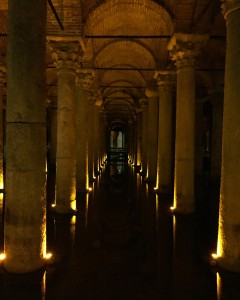 Driving in from the airport, Istanbul feels like an European city but with some interesting twists. The highway drives past the massive city walls and Roman aqueducts. Domed mosques and red Turkish flags dot the 7 hills of Istanbul. Piped in prayer music reverberates throughout the city – starting at 5:40 am. I look forward to spending more than 24 hours in Istanbul.
Driving in from the airport, Istanbul feels like an European city but with some interesting twists. The highway drives past the massive city walls and Roman aqueducts. Domed mosques and red Turkish flags dot the 7 hills of Istanbul. Piped in prayer music reverberates throughout the city – starting at 5:40 am. I look forward to spending more than 24 hours in Istanbul.
